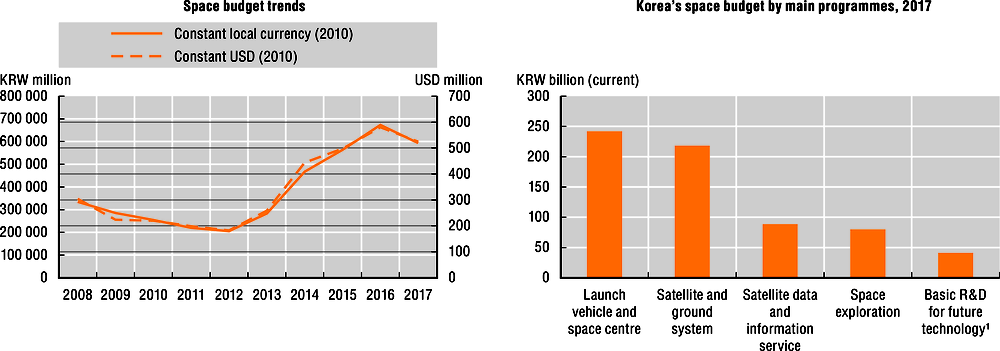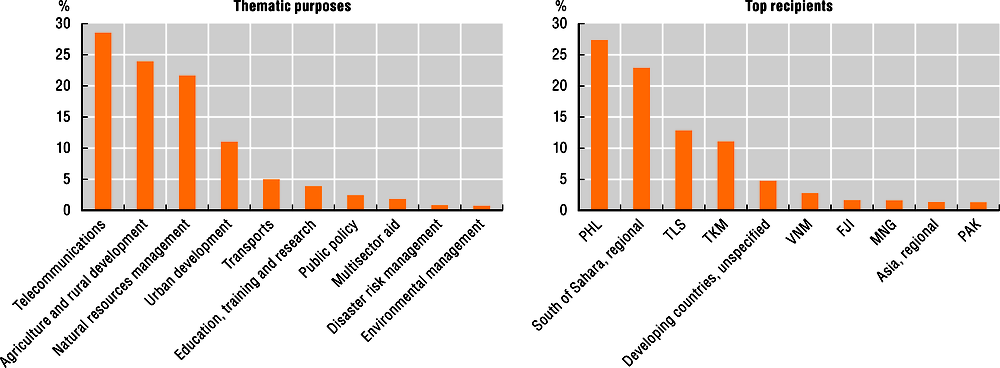16. Korea
Korea’s first space programme dates back to the late 1980s with its first successful launch using the domestic KSLV-1 launcher in 2013. It is one of a small number of countries with independent access to space from the Naro Space Centre. The Korea Aerospace Research Institute (KARI) manages the Korean space programme, under the responsibility of the Ministry of Science, ICT and Future Planning.
In 2018, the Third Space Development Plan identified the key space policy objectives, with six focus areas: indigenous development of launcher technologies; development of satellite technologies and increased use of data and applications for society; lunar space exploration; establishment of the Korea Positioning System (KPS); strengthening of the national innovation capacity through public-private-academic collaboration; and space industry promotion and space sector job creation, through more private participation in space development and commercialisation activities (Government of Korea, 2018[1]).
Korea sees space exploration as an important stepping stone for developing national capabilities. A lunar orbiter is scheduled for 2020, which will carry five domestic payloads and one payload developed by NASA. Objectives include, for instance, to test lunar exploration technologies, demonstrate a “space internet”, conduct scientific investigations of the lunar environment and surface, and identify potential landing sites for future missions. A lunar lander mission is planned for 2030. In May 2019, the Korea Astronomy and Space Science Research Institute and NASA agreed to jointly build a payload device for NASA’s lunar landers scheduled for launch in the 2020s.
Korea is also reinforcing its positioning, timing and navigation infrastructure. A satellite-based GPS augmentation system is to be deployed in 2022. As mentioned above, this will be followed by a regional satellite navigation system (KPS) in the 2030s.
It is a priority to increase the utilisation of Korean government satellite data. KARI’s Satellite Operation Centre was in 2015 designated as a National Satellite Operation and Application Centre. The objective is to create an integrated management system and to improve and facilitate the distribution of data to both public and private actors.
In 2017, the Korean government allocated some KRW 670.3 billion (USD 593 million) to space activities in KARI, a 77% increase in real terms compared with 2008. The biggest budget posts were launchers and the space centre (36% of the total), followed by satellite and ground infrastructure development (33%).
Space-related research activities are carried out in several government research agencies (e.g. KARI, Korea Astronomy and Space Science Institute (KASI), Electronics and Telecommunications Research Institute (ETRI)), and many universities also have aerospace and space science programmes, notably Korea Advanced Institute of Science and Technology (KAIST) and Seoul National University.
The Korean space industry has capabilities in most space industry segments, including space vehicle and equipment manufacturing, satellite launch, satellite operations and downstream applications. The Korean space industry generated some KRW 2 779.3 billion (USD 2.4 billion) in revenues 2016 and employed almost 6 000 persons (KARI, 2017[2]). Research centres are generally found in Daejeon in conjunction with KARI, while companies are mostly located in the Seoul metropolitan area.
Space manufacturing companies have contributed to government programmes for decades and produce components, parts and equipment. There are important links to other sectors such as aerospace and defence, ICT, automotive and maritime industries. While KARI remains the main driver of space manufacturing activities in Korea, it increasingly transfers activities and capabilities to private sector companies and consortiums (Kim, 2015[3]). Downstream applications and equipment play an important role in terms of commercial revenues and exports. This includes in particular the manufacturing of equipment for satellite telecommunications and navigation (e.g. direct-to-home set-top boxes, antennas, GNSS receivers). In 2016, the satellite services and equipment segment accounted for 87% of space industry revenues and 98% of exports (KARI, 2017[2]).
Korea’s share in scientific publications in the OECD “Space literature” dataset has increased since 2000 and is comparable to that of Switzerland and Sweden (see guide to the profiles). It ranks among the top countries in space-related patent applications. Satellite TV penetration in Korea has increased significantly since 2002, although growth has slowed down in the last years. Satellite broadband penetration is very low, with the country mainly connected by high-speed fibre. Space-related official development assistance projects in the 2000-16 period focussed on telecommunications and agriculture and rural development, with recipients located mainly in the sub-Saharan region.
References
[1] Government of Korea (2018), 제3차우주개발 진흥 기본계획, [Third Space Development Plan], Government of Korea, Seoul.
[2] KARI (2017), 2017 우주산업 실태조사, [2017 Space Industry Survey], Korea Aerospace Research Institute, Daejeon.
[3] Kim, E. (2015), “National Strategies to Support Space Industry in Korea”, presentation at the OECD Space Forum Workshop: Policy Instruments Supportive of National Space Programmes: Practices from Around the World, 8 November, Paris.






